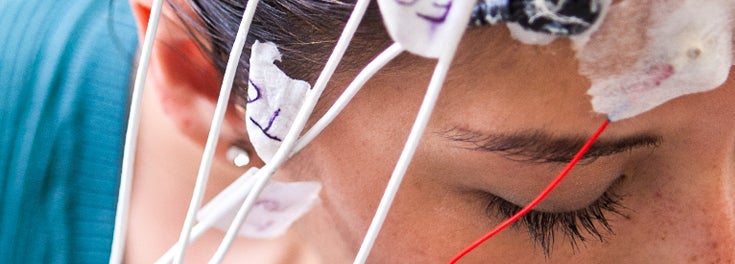
If the human brain is what gets your electrodes racing, you can choose from about a dozen different approaches to studying brain science as an undergraduate at URI—from biochemistry and psychology to pharmacy, engineering, communicative disorders and more. And grad students can enroll in our Interdisciplinary Neuroscience Program, which draws on the expertise of researchers in six colleges on campus.
Regardless of which direction you choose, you’ll have the opportunity to study and learn as part of URI’s newest research center, the George & Anne Ryan Institute for Neuroscience.
Neuroscience is probably the area of biology that we know least about, so there’s the most potential for groundbreaking discoveries.
The Ryan Institute is engaging scientists and students in solving some of the most pressing health care challenges we face today, focusing on neurodegenerative diseases and disorders like Alzheimer’s disease, Parkinson’s disease and ALS. The Institute is led by an international expert in the study of Alzheimer’s, Paula Grammas, who joined the faculty this month to build the institute into a research and education powerhouse by creating partnerships with Brown University, local hospitals and others.
“Neuroscience is probably the area of biology that we know least about, so there’s the most potential for groundbreaking discoveries,” Professor Grammas said. “Where we were with the cardiovascular system in the 1960s is where we’re at with the nervous system now. And think how far we’ve come.”
Her pioneering research has revealed the important role that blood vessels and inflammation play in the development of Alzheimer’s and other diseases. That work complements that of Pharmacy Professor Nasser Zawia, whose studies have found that Alzheimer’s has its foundations in infancy when babies are exposed to low levels of lead.
When you study neuroscience at URI, you’ll be able to draw on the expertise of Professors Grammas and Zawia and the more than 30 other faculty involved in brain-related research. Like Biomedical Engineering Professor Walt Besio, who invented an electrode so sensitive that it can translate a person’s thoughts into electrical impulses that can be read by a computer, eventually enabling people who are paralyzed to use their thoughts to control their phone, television or other devices.
Or you could assist Communicative Disorders Professor Leslie Mahler as she leads a clinical support group for people living with Parkinson’s disease, helping the patients overcome the speech disorders that typically result from the disease. Dubbed the Loud Crowd, they work on strategies to correct their slurred or monotone speech, breathy or hoarse voice, and reduced vocal volume, all of which result from underlying neural mechanisms.
Graduate student Aseel Eid says URI’s interdisciplinary approach to the study of neuroscience “helps remind you why you are here—to do work that directly benefits patients. I love the URI neuroscience program because it requires us to solve real problems.”
The Ryan Institute for Neuroscience was established by a $15 million donation from URI graduate Thomas M. Ryan, former CEO of CVS Caremark, and his wife Cathy, who named it in honor of his late parents. In addition to seeking cures for brain disorders and diseases, scientists at the Institute are training future scientists in a field that’s increasingly important as people live longer and experience more neurological disorders later in life.
At URI, the opportunities available to expand your mind about brain science are as thought-provoking as the brain itself.
